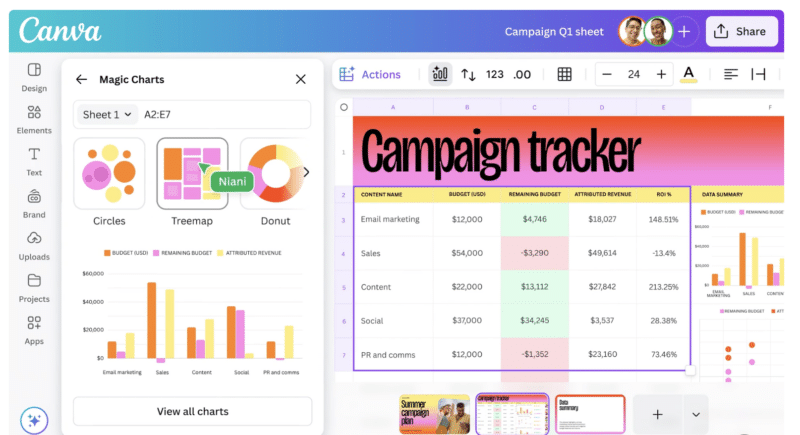Canva’s Visual Suite upgrade unifies campaign planning and creation
The upgrade puts design and productivity tools in one platform, making it easier to create, execute and monitor campaigns.
Canva this week launched Visual Suite 2.0, the company’s biggest product launch since 2013. It’s a significant overhaul designed to integrate design and productivity tools into a single platform.
Visual Suite 2.0 gives marketers faster and more efficient tools for planning, creating and executing campaigns. Here’s what’s new:
Visual Suite in One Design
Visual Suite in One Design lets users create different marketing materials within a single design space, from presentations and documents to videos and websites. Canva says this eliminates the need for separate tools, fragmented workflows and disconnected files.
Users can plan a campaign, design the graphics, write the accompanying document and create a landing page within one Canva project. The unified approach streamlines users’ workflow from ideation to delivery. Also, teams can work on different aspects of a campaign simultaneously within the same project using tab windows.
Dig deeper: 12 over-looked content marketing tools and features you should be using
Canva Sheets
Canva Sheets is described as “more than just a spreadsheet.” It lets users combine text with visual assets, making data analysis and reporting more engaging. Key features include:
- Magic Insights automatically scans data to identify notable patterns and takeaways. This helps users quickly understand campaign performance and identify key trends.
- Data Connectors can import data from third-party platforms like HubSpot, Statista and Google Analytics directly into Canva. Eliminating manual data entry ensures users’ visuals are based on the latest information.
- Magic Studio at Scale lets users transform spreadsheet data into various content formats by automatically populating templates. Think instantly creating personalized marketing materials or multi-market campaign variations from a single data source.
Magic Charts
The Magic Charts feature uses AI to convert raw numbers into dynamic and on-brand visuals. Users can create interactive graphs, infographics, reports and animated visualizations, making communicating marketing results and insights easier.

Canva AI
Canva AI is accessed via text or voice prompts. It can generate text and slides and tweak elements of users’ projects, like resizing designs. This can help overcome creative blocks, quickly generate initial drafts and adapt content for different platforms.
Canva Code
Canva Code, through a partnership with Anthropic, lets users generate widgets, websites and other interactive content using natural language prompts without any coding or external tools required. Things like embedded calculators, interactive polls or mini-applications can be created directly within marketing designs to boost audience engagement.
Dig deeper: Does your team struggle to evaluate creative ideas? You’re not alone
Upgraded Canva Photo Editor
The upgraded Canva Photo Editor promises “professional-grade,” AI-powered edits. Enhancements include:
- Object removal and modification with point-and-click simplicity.
- Create AI-generated backgrounds that intelligently consider lighting and layout.
- Point-and-click selection of elements for easy editing. These features let users enhance product photos quickly, create visually appealing social media posts and ensure brand consistency.
Canva’s Visual Suite 2.0 is the company’s attempt to bridge the gap between creativity and productivity. Canva also emphasizes trust, safety and privacy with Canva Shield. The program can’t use private content for AI training without permission.
MarTech is owned by Semrush. We remain committed to providing high-quality coverage of marketing topics. Unless otherwise noted, this page’s content was written by either an employee or a paid contractor of Semrush Inc.
Related stories
New on MarTech